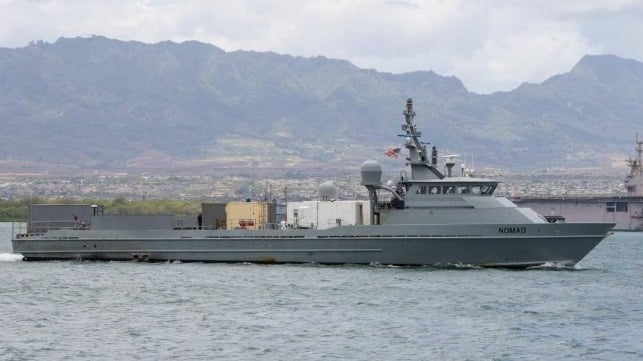U.S. Navy Christens its Third Autonomous Crewboat

The U.S. Navy has added a third vessel to its fleet of medium-sized uncrewed workboats, which were first developed and unveiled by the Pentagon-run "Operation Overlord" program. The newly-christened Mariner is the first newbuild in this adapted flotilla: all are crewboat designs, and the first two - Nomad and Ranger - began their lives working in the Gulf oil patch.
Mariner is a modern 200-foot crewboat built at Gulf Craft and adapted to the Navy's needs before delivery. The vessel was built to a commercial series design with a high degree of automation, lending itself well to further upgrades for uncrewed operation. It has eight TEU of container capacity on the back deck and two more forward for modular payloads.
Mariner was christened in a ceremony Tuesday at the U.S. Naval Academy, where she is on display to introduce the concept of uncrewed operations to cadets and more senior personnel alike. She will soon join the Navy's other USVs in San Diego, under the supervision of Surface Development Squadron One.
A fourth purpose-built Overlord USV is under construction now at the Austal USA yard in Alabama, with oversight from L3Harris. SURFDEVRON One also has two slightly smaller USVs, the trimarans Sea Hunter and Sea Hawk, built by Leidos under a DARPA program.
With its growing uncrewed fleet, the Navy hopes to accelerate up the learning curve with USV operations by operating multiple vessels at once. Rear Adm. Casey Moton told Defense News that Mariner is equipped to allow remote-control testing to proceed without pulling a destroyer off duty to serve as a command platform.
In addition to working out the details of how to make the technology function for months at sea without any service, the testing program is designed to help the Navy figure out how it wants to use medium USVs in the high-end fight - whether as supply boats, scouts, auxiliary magazine ships, and in what size and configuration. Congress has asked for a clearer vision of what these vessels might be used for, and why uncrewed systems are a funding priority (as opposed to simply more crewed hulls). A high-profile uncrewed appearance at the Rim of the Pacific international naval exercise this year was intended to showcase these systems' capabilities and explore how they could be deployed in a teamed environment, and the Navy says that it will be examining the data and results from those maneuvers carefully.
